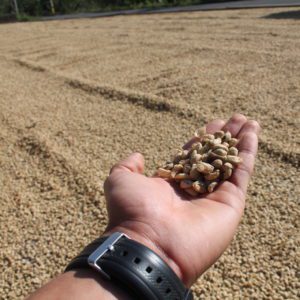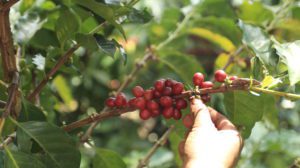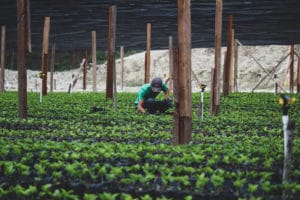While coffee gets most people ready for the day, the supply chain that provides the coffee that powers us is more important than we realize. Before a bag of coffee arrives on a grocery store shelf, many lives have been impacted by the growth and sale of that coffee. We thought we’d delve into the economic factors behind the scenes, or behind the bag of coffee, and the impact a sale can have.
Although much of the world now focuses on technology and services to stimulate their economies, one crop can still have an effect on the economy of a country. That’s the case with Honduras, where coffee exports comprise about 5% of total GDP and 30% of agricultural GDP. Coffee prices soared from 2020 to 2021. With 102,000 (mostly small) farms producing coffee and around one million jobs dependent on coffee, its success can make a big difference.

Unfortunately, just recuperating previous success is the name of the game for many. That’s because of recent growing struggles and upsets due to weather, pests and COVID-19. Luckily, the world is starting to recognize the decadent flavors coming from small, premium coffee operations. Overall, coffee in Honduras can bolster local and country-wide economies.
Honduras in the World of Coffee
Honduras is located two countries south of Mexico in Central America. It has grown coffee since the 19th century. The fact that more and more people are consuming coffee worldwide combined with the Honduran hills’ capacity to produce excellent beans for single-origin bags is a recipe for success.
Honduras has consistently ranked in the top 10 coffee producers in the world. With disruptions in Colombia and Brazil, Honduras can be the next hotspot for coffee growth. Currently, Honduras serves up coffee—or at least the beans and grounds—to over 55 countries worldwide. Recently, it even began shipping coffee to South Korea, due to the new trade agreement. That is quite a long span for Honduran beans to breach horizontally. Coffee grows in Indonesia and Papua New Guinea, which are closer to South Korea. The coffee world map is fascinating, with trade tendrils reaching out north and south from the central band of the greater equatorial region.
A View into Honduran Coffee
A country with beautiful beaches, rich wildlife-filled rainforests, impressive mountains and a long, interesting history, Honduras is underrated. Life is simpler for many people, which is reflected in the relative importance of coffee to the economy. Agriculture represents 12% of GDP and coffee is the highest priced crop. Western Honduras grows the majority of the coffee. However, it is grown in 83% of the departments throughout the country, which are like states.
Cooperatives like Cooperativa Cafetalera Capucas Limitada (COCAFAL) have unified specialist smallholders. The rise in the standard of living for many Hondurans owes to such groups. Coffee results in more financial transactions with other countries than any other element of the economy. Considering there are more and more coffee lovers worldwide, this is excellent news. People outside the mostly equatorial coffee belt, in the north and south cannot shop locally for coffee. Choosing to buy from an area where the purchase will do a lot of good is an excellent decision.
Government Support of Coffee
Coffee drinkers who choose Honduran coffee will be pleased to know that the government helps foster successful coffee growth. Weather and logistical issues challenge those in agriculture around the equator. It’s great news that the government is willing to help farmers, processers and transporters of coffee.
Specifically, the Honduran government provides lines of credit, scholarships and technical programs to help people prepare for successful farming. Lack of money to invest and debt are problems for the smaller farmers. Without the ability care for and protect plants, pest problems can wreak extra havoc.
The government also helps with fertilizers, capacity building and improving genetics laboratories. By improving supply chain infrastructure, they ensure that materials and tasty coffee can all get where they need to go at the right time. Without such help, small and large coffee farmers would struggle.
Coffee leaf rust is another challenge. Worldwide, this fungus has been leaving yellow-orange spots that have turned farmers’ stomachs with dread since before the U.S. Civil War. However, when wild coffee plants die from leaf rust, they stop being potential hosts for other destructive creatures like beetles. Government support is important to prevent leaf rust, combat the ramifications when it shows up and to control other pests.

Recent Challenges and Successes
Coffee Growth Challenges
The current state of the coffee industry in Honduras holds both good and bad news. While high coffee prices have infused the industry with excitement and cash, expected and unexpected challenges have arisen too. Rainy weather has fostered the growth of leaf rust. Rain in the forecast can bring mixed feelings or even bad feelings in coffee-growing areas.
Another challenge results from an event ten years ago. A large-scale re-planting effort from that time has resulted in an anticipated cyclical decline. Pandemic-related issues also remain.
A Promising Outlook
On the whole, the growth of coffee in Honduras improved in the last year. Of course, pandemic shutdowns and logistical problems were a low, unforeseen situation. Vaccines improved the situation and allowed for the global economic reopening. With the upheaval in established trade relationships and labor arrangements, the chance to meet demand previously met by the top five coffee producers is a promising opportunity for Honduras.
The Power of Small, Consistent Purchases
An organization that foresaw the potential benefits for the local community and greater economy brought by coffee farming is the Moses Project. Its gourmet coffees created for a great cause are sold by its brand Subida Coffee Co. It’s a non-profit where 100% of the proceeds go to charity. The Moses Project houses and educates youth who would have trouble continuing their education otherwise.
At this 120-acre farm, around 40 boys receive a traditional and agricultural education at once. They learn about aquaculture and beekeeping as well. With such skills, education and improved outlook for the future, the boys can help stabilize and improve their local and even regional economies.

The agricultural center and farm is located just outside Santa Rosa de Copán. This city is a seat of its department. With the concentration of coffee farms in Honduras’ western areas, cooperatives in the country and prioritization by the government, successful coffee growth there can help combat the effects of the pandemic and other recent challenges. Honduras could even take advantage of recent changes in the worldwide coffee market to secure a more stable and profitable piece of the pie.
At The Moses Project, the plants are cared for by hand and then roasted in small, controlled batches. The extra care they receive and the human-made choice to pluck at the peak of ripeness results in consistent, gourmet single-origin coffee. Offering a dark and medium roast, available in a subscription model, coffee can bring people together, regardless of borders, for a great cause. Americans must choose somewhere from the coffee belt to purchase from. The Honduran economy is greatly bolstered by small, consistent investments.

